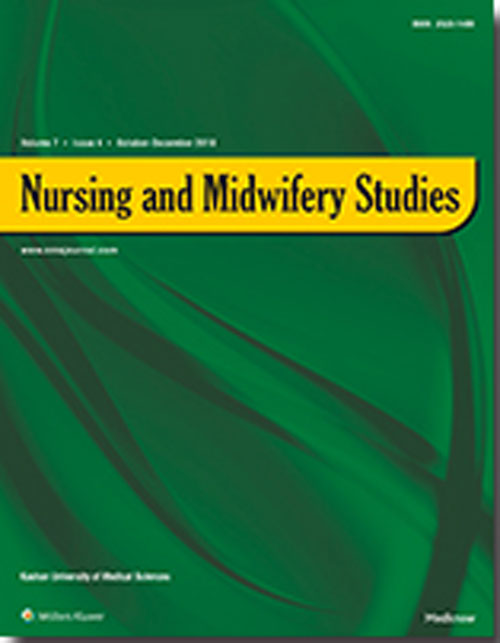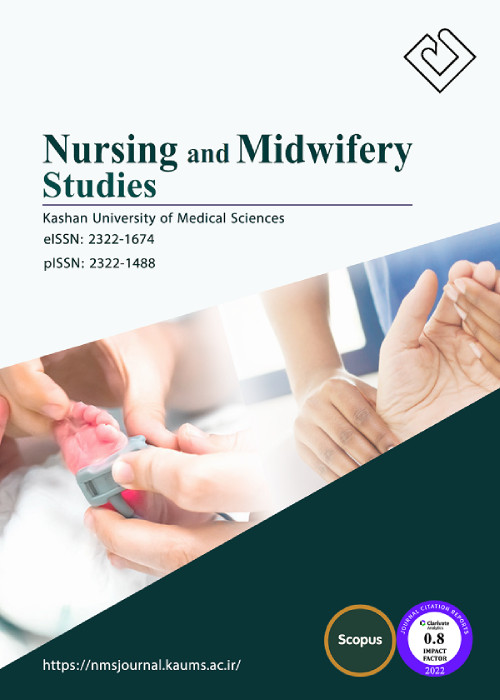فهرست مطالب

Nursing and Midwifery Studies
Volume:7 Issue: 4, Oct-Dec 2018
- تاریخ انتشار: 1397/07/25
- تعداد عناوین: 8
-
-
Pages 145-150BackgroundPatients with breast cancer (BC) suffer from sleep disorders, pain, fatigue, and nausea after receiving chemotherapy.ObjectivesThe objective of this study was to assess the effects of the continuous care model (CCM) on sleep quality, pain, fatigue, and nausea among patients with BC who were receiving chemotherapy.MethodsThis randomized clinical trial was conducted on 78 patients with BC who referred in April–June 2013 to the chemotherapy clinic of Ahvaz University of Medical Sciences, Ahvaz, Iran. Initially, patients were paired with each other respecting their age, type of surgery, and educational level, and then through tossing a coin, one patient in each pair was randomly allocated to the intervention and the other to the control group. The CCM was used for care provision to patients in the intervention group, while care services were provided to patients in the control group through routine methods. Data were collected 4 days after chemotherapy onset and 2 months after the intervention using a demographic questionnaire, a visual analog scale for nausea assessment, the Pittsburgh Sleep Quality Index, the Brief Fatigue Inventory, and a 10-cm ruler for pain assessment. For data analysis, the independent-sample t and the Chi-square tests were used.ResultsBefore the intervention, the groups did not significantly differ from each other concerning the scores of sleep quality, fatigue, pain, and nausea (P > 0.05). However, after the intervention, between-group differences of the intervention group and the controls were statistically significant for sleep quality (7.81 ± 4.50 vs. 16.80 ± 4.32, P < 0.0001), fatigue (36.23 ± 15.60 vs. 61.00 ± 12.32, P < 0.0001), pain (2.90 ± 2.82 vs. 6.81 ± 2.31, P < 0.0001), and nausea (2.16 ± 2.90 vs. 5.2 ± 2.93, P < 0.0001).ConclusionThis study proves the positive effects of the CCM on sleep quality, pain, fatigue, and nausea among patients with BC. Nurses can use this model to improve the patient outcomes.Keywords: Breast cancer, Chemotherapy, Fatigue, Long?term care, Models, Nausea, Nursing, Pain, Sleep
-
Pages 151-156BackgroundPrimary dysmenorrhea (PD) is one of the most common gynecologic problems.ObjectivesThe objective of this study was to determine the effects of dry cupping on PD severity and dysmenorrhea-associated systemic symptoms.MethodsIn this randomized clinical trial, 150 young single students with PD were randomly allocated to either an intervention (n = 75) or a control (n = 75) group. Data collection tools were a demographic and menstrual characteristics checklist, Andersch and Milsom's Verbal Multidimensional Dysmenorrhea Severity Scoring System, and a Dysmenorrhea-associated Systemic Symptom Scale. In the intervention group, students were provided with daily sliding dry cupping therapy from 3 days before to 3 days after the onset of menstruation for three successive menstrual cycles. In each cupping therapy session, two cups were placed on the lower back on each side of the spine and another on the suprapubic area for 10–15 min. Students in the control group did not receive cupping therapy. Data were analyzed through the Chi-square and the independent-samples Student's t-tests, the repeated measures analysis of variance, and generalized estimating equation.ResultsThe mean scores of dysmenorrhea severity and systemic symptoms in the intervention group significantly decreased over time, while they did not significantly change in the control group. Thus, there were significant between-group differences respecting the variations of dysmenorrhea severity and systemic symptoms over time (P = 0.03). The odds of severe dysmenorrhea and the odds of severe dysmenorrhea-associated systemic symptoms in the intervention group were, respectively, 52% (odds ratio [OR]: 0.48; 95% confidence interval [CI]: 0.27–0.85) and 78% (OR: 0.22; 95% CI: 0.05–0.98) less than the control group.ConclusionDry cupping can significantly reduce the severity and the systemic symptoms of PD. Therefore, it can be used as an effective, inexpensive, and safe therapy for PD management.Keywords: Dry cupping, Primary dysmenorrhea, Systemic symptoms
-
Pages 157-162BackgroundStaff turnover, particularly nursing staff turnover, is one of the most common reasons behind loss of productivity in health-care organizations. A basic requirement for reducing staff turnover is to determine its causes.ObjectivesThis study evaluated the relationships of perceived organizational justice, organizational commitment, and job satisfaction with turnover intention among a group of Iranian hospital nurses.MethodsThis cross-sectional study was conducted on nursing staff and auxiliary nurses who were working in 15 teaching hospitals affiliated to Shiraz University of Medical Sciences, Shiraz, Iran. A random sample of nurses, who had an associate or higher degrees in nursing and had a work experience of >1 year, was recruited through stratified random sampling. Data were collected using a demographic questionnaire, the Organizational Justice Questionnaire, the Job Satisfaction Questionnaire, the Organizational Commitment Questionnaire, and the Questionnaire of Turnover and were analyzed through the confirmatory factor analysis, path analysis, Pearson's correlation analysis, and squared multiple correlation analysis.ResultsOrganizational justice had significant direct relationships with job satisfaction (r = 0.73) and organizational commitment (r = 0.61) and inverse relationship with turnover intention (r = −0.41). Path analysis revealed that organizational justice had no direct effects on turnover intention, while it had indirect effects on turnover intention through the paths of organizational commitment and turnover intention.ConclusionNurses' turnover intention is directly affected by organizational commitment and job satisfaction and indirectly affected by organizational justice through the paths of organizational commitment and turnover intention.Keywords: Hospitals, Job satisfaction, Nurses, Personnel turnover, Social justice
-
Pages 163-167BackgroundHospitalization of infants with congenital anomalies to undergo surgery is extremely stressful for their family members, particularly their parents. The resultant stress can negatively affect parents' self-confidence.ObjectivesThe aim of this study was to examine the correlation of perceived nursing support with stress and self-confidence among the mothers of infants with congenital gastrointestinal anomalies.MethodsThis correlational study was conducted in June–November 2015 on 120 mothers whose infants were hospitalized due to congenital gastrointestinal anomalies in the surgical ward of Tabriz teaching children's hospital, Tabriz, Iran. Data were collected using a demographic questionnaire, the Nurse Parent Support Tool, the Parental Stress Scale, and the Parenting Confidence Scale. Spearman's correlation analysis was used to assess the correlation of perceived nursing support with stress and self-confidence.ResultsMothers perceived high levels of communicational-informational nursing support and low levels of emotional nursing support. Perceived nursing support had positive correlations with stress (r = 0.22; P = 0.013) and self-confidence (r = 0.35; P < 0.001).ConclusionAlthough the mothers of infants with congenital gastrointestinal anomalies receive adequate communicational-informational nursing support, their perceived emotional nursing support is inadequate. Therefore, neonatal care nurses need to provide the mothers with comprehensive support and adopt strategies to alleviate their concern.Keywords: Infant, Mother, Nursing support, Self?confidence, Stress
-
Pages 168-173BackgroundParents of children with autism need to have unique competencies which are different from the competencies of parents with healthy children. Nurses and other health-care providers should know these competencies to be able to provide these parents with quality care and education.ObjectivesThis study aimed to define the concept of parental competence from the perspectives of parents with autistic children. The main question of the study was, “What does parental competence mean?”MethodsThis qualitative study was done in 2016 on 20 parents (12 mothers and eight fathers) of 20 autistic children. Parents were purposively recruited from the Autism Association of Shiraz University of Medical Sciences, Shiraz, Iran. Data collection was done through 16 semi-structured interviews and two focus group discussions. Interviews and focus group discussions were digitally recorded, transcribed verbatim, and analyzed using conventional content analysis.ResultsData analysis led to the development of 13 subcategories, five main categories, and two main themes, namely, “restoration of family stability” and “excellence in child care.” The three main categories of the first theme were adaptation to the current situation, organization of family affairs, and improvement of satisfaction in the family. The second main theme also had two main categories, namely, self-confidence in child care and stability on the difficult path of child care.ConclusionParental competence among parents with autistic children is defined as “the ability to restore family stability and achieve excellence in child care.” Appropriate strategies are needed to evaluate and improve parental competence among parents with autistic children.Keywords: Autism spectrum disorders, Child, Competence, Parents
-
Pages 174-179BackgroundThe students' average achievement test scores cannot predict the students' academic success appropriately.ObjectivesThis study aimed to determine the psychometric properties of Persian version of the Academic Success Inventory for College Students (ASICS).MethodsThe study was conducted in four steps of translation, face and content validity, exploratory factor analysis, and reliability assessment.ResultsThe final version of the Persian version has 38 items. Ten factors with an eigenvalue more than one were extracted. Internal consistency of the scale was 0.75. Item-total correlation ranged from 0.33 to 0.7 for all items and the mean item-total correlation was between 2.20 and 2.90.ConclusionThe Persian version of ASICS showed appropriate psychometric properties. It can be used to assess the academic success of Iranian college students.Keywords: Academic success, Nursing students, Psychometrics, Scale
-
Pages 180-185BackgroundImage remains crucial for nursing profession. How nurses view professional self-image has an impact on their professional self-esteem.ObjectivesThis study explored the image of nursing as perceived by Indonesian nurses.MethodsThis was a phenomenological study with a purposeful sample of 19 clinical nurses participated in in-depth interviews. The interviews were audio-recorded, transcribed verbatim, and validated by relistening to the recording by researchers. The analysis was thematic.ResultsFive themes emerged (a) Islamic culture, (b) job definition, (c) role of nurses, (d) self-confidence, and (e) relationship between multigenerations of nurses.ConclusionThis study addressed positive and negative images of nursing in Belitung, Indonesia. The findings may be used for nurse managers to improve nursing image through the improvement of nurse competence and continuing professional development.Keywords: Auditory perception, Humans, Indonesia, Self?concept, Nurse administrators
-
Pages 186-191BackgroundHomeless women can provide valuable information about the prevalence of sexually transmitted infections (STIs), especially human immunodeficiency virus (HIV) infection, in Iran. However, they are not readily accessible for epidemiological studies and hence, there is limited information about HIV infection prevalence among them.ObjectivesThe aim of the present study was to assess the prevalence of HIV infection and the perceptions of STIs among homeless women in Tehran, Iran.MethodsThis cross-sectional study was conducted in 2014. Participants were 241 homeless women who were recruited through quota sampling from twelve drop-in centers and night shelters affiliated to a local welfare organization in Tehran, Iran. Data were collected using the perception of STIs Questionnaire as well as serological testing for HIV infection using DS-EIA-HIV-Ag/Ab-Screen kit (manufactured in Italy). Descriptive statistics measures and the independent-samples t-test were used for data description and analysis.ResultsThe prevalence of HIV infection was 8.3%. There were significant differences between HIV-positive and HIV-negative women respecting their overall STI risk perception (P = 0.003) and its two subscales, namely insufficient knowledge (P = 0.007) and inconsistent condom use (P = 0.030).ConclusionHomeless women have low STI risk perception. Training and counseling programs are necessary to improve their STI-related knowledge, perception, and attitudes.Keywords: Homeless women, Human immunodeficiency virus, Sexually transmitted infections


